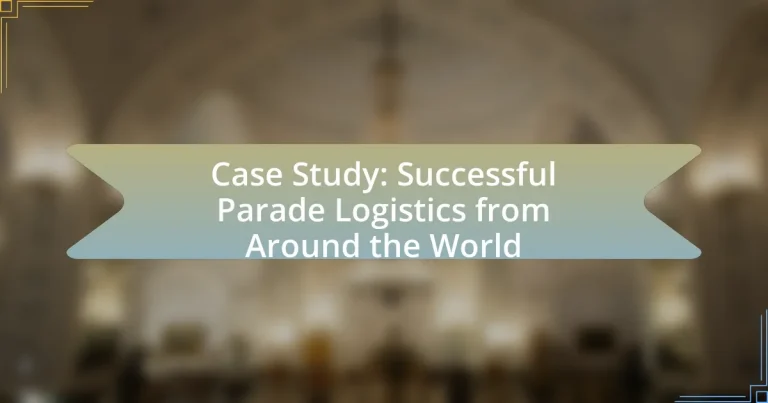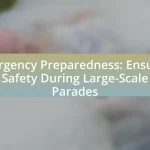The article focuses on parade logistics, detailing the essential planning, coordination, and execution required for successful parades worldwide. It highlights the unique challenges faced by organizers, such as crowd management and safety protocols, and discusses key components like resource management and communication strategies. Case studies, including the Macy’s Thanksgiving Day Parade and the Rose Parade, illustrate effective logistical practices and the impact of technology on event coordination. The article also emphasizes best practices and lessons learned that can be applied to future events, ensuring safety and enhancing the overall experience for participants and spectators.

What are Parade Logistics and Why are They Important?
Parade logistics refer to the planning, coordination, and execution of all activities and resources necessary for a parade to occur smoothly. This includes managing the route, securing permits, coordinating with law enforcement, arranging for transportation and staging of floats, and ensuring the safety of participants and spectators. Effective parade logistics are crucial because they ensure the event runs on time, maintains public safety, and enhances the overall experience for attendees. For instance, the Macy’s Thanksgiving Day Parade in New York City involves extensive logistical planning, including the use of over 2,000 volunteers and coordination with multiple city agencies to manage crowds and traffic, demonstrating the importance of logistics in executing a large-scale public event successfully.
How do Parade Logistics differ from other event logistics?
Parade logistics differ from other event logistics primarily due to their unique requirements for crowd management, route planning, and safety protocols. Unlike typical events that may occur in a confined space, parades often take place on public streets, necessitating extensive coordination with local authorities for road closures and traffic control. For instance, the Macy’s Thanksgiving Day Parade in New York City involves detailed planning to manage millions of spectators and requires collaboration with police and emergency services to ensure safety and efficient crowd flow. This complexity in logistics is further amplified by the need for float assembly, performer coordination, and real-time communication during the event, distinguishing parade logistics from standard event logistics that may not face such extensive public interaction and safety challenges.
What key components are involved in effective parade logistics?
Effective parade logistics involve several key components: planning, coordination, resource management, safety measures, and communication. Planning includes route selection, timing, and permits, ensuring that all logistical aspects are organized well in advance. Coordination among various stakeholders, such as local authorities, emergency services, and participants, is crucial for smooth execution. Resource management encompasses the allocation of personnel, equipment, and materials necessary for the parade. Safety measures involve crowd control, emergency response protocols, and risk assessments to protect participants and spectators. Lastly, effective communication ensures that all parties are informed and can respond promptly to any issues that arise during the event.
How do logistics impact the overall success of a parade?
Logistics significantly impact the overall success of a parade by ensuring efficient coordination of resources, timing, and safety measures. Effective logistics management involves planning the route, scheduling participants, and coordinating with local authorities, which directly influences the parade’s flow and audience experience. For instance, the Macy’s Thanksgiving Day Parade in New York City exemplifies successful logistics through its detailed planning, including traffic management and crowd control, which accommodates over 3 million spectators annually. This meticulous organization not only enhances safety but also ensures that the parade proceeds smoothly, contributing to its reputation as a premier event.
What challenges do organizers face in parade logistics?
Organizers face several challenges in parade logistics, including crowd management, safety concerns, and coordination with local authorities. Effective crowd management is crucial to ensure the safety of participants and spectators, as large gatherings can lead to overcrowding and potential hazards. Safety concerns also encompass emergency response planning, as organizers must prepare for medical emergencies or unforeseen incidents during the event. Additionally, coordination with local authorities is essential for securing permits, managing road closures, and ensuring compliance with regulations, which can be complex and time-consuming. These challenges highlight the need for meticulous planning and collaboration among various stakeholders to ensure a successful parade.
How do weather conditions affect parade logistics?
Weather conditions significantly impact parade logistics by influencing planning, safety measures, and participant comfort. For instance, rain can lead to the need for waterproof equipment, altering the route to avoid flooding, and implementing additional safety protocols to prevent slips and falls. Historical data shows that parades held in inclement weather often experience lower attendance, as seen during the 2018 New York City St. Patrick’s Day Parade, where rain reduced spectator numbers by approximately 30%. Additionally, extreme temperatures can affect the health of participants and attendees, necessitating hydration stations and shade provisions. Thus, effective parade logistics must account for weather forecasts to ensure safety and enhance the overall experience.
What are the common logistical issues encountered during parades?
Common logistical issues encountered during parades include crowd management, transportation coordination, and resource allocation. Crowd management is critical as large gatherings can lead to safety hazards and congestion, requiring effective planning to ensure smooth movement and emergency access. Transportation coordination involves organizing the arrival and departure of participants, floats, and equipment, which can be complicated by road closures and traffic disruptions. Resource allocation refers to the distribution of necessary supplies, such as barriers, signage, and personnel, which must be meticulously planned to avoid shortages or misplacement during the event. These issues are frequently documented in case studies of major parades, highlighting the importance of thorough logistical planning to mitigate risks and enhance the overall experience.

What are Some Successful Parade Logistics Case Studies?
Successful parade logistics case studies include the Macy’s Thanksgiving Day Parade in New York City, which effectively manages over 2.5 million spectators and 1,000 volunteers annually by utilizing a detailed logistical plan that includes route mapping, crowd control, and emergency services coordination. Another example is the Rose Parade in Pasadena, California, which showcases a meticulously organized event involving over 40 floats and 20 marching bands, supported by a robust volunteer network and extensive media coverage to ensure smooth operations. These case studies demonstrate the importance of strategic planning, resource allocation, and community involvement in executing large-scale parades successfully.
How did the Macy’s Thanksgiving Day Parade manage its logistics?
The Macy’s Thanksgiving Day Parade managed its logistics through meticulous planning and coordination involving multiple stakeholders. The event organizers collaborated with city officials, law enforcement, and various service providers to ensure safety and efficiency. For instance, the parade route is carefully mapped out, and logistical elements such as float assembly, balloon inflation, and participant staging are scheduled in advance to streamline operations. Additionally, the use of technology, including GPS tracking for floats and real-time communication systems, enhances coordination among teams. This comprehensive approach has been essential in managing the complexities of one of the largest parades in the world, which attracts millions of spectators annually.
What strategies were implemented to ensure safety and efficiency?
To ensure safety and efficiency during parades, comprehensive planning and coordination strategies were implemented. These strategies included the establishment of clear communication protocols among all stakeholders, including law enforcement, emergency services, and event organizers, which facilitated rapid response to any incidents. Additionally, crowd management techniques, such as designated entry and exit points, were utilized to control the flow of participants and spectators, minimizing congestion and potential hazards. Furthermore, risk assessments were conducted prior to the event to identify and mitigate potential safety issues, ensuring that all safety measures were in place. These strategies have been proven effective in various successful parades globally, demonstrating their importance in achieving a safe and efficient event.
How did technology play a role in the logistics of the parade?
Technology significantly enhanced the logistics of the parade by enabling real-time communication and coordination among various teams. Advanced software applications facilitated the tracking of participants, vehicles, and equipment, ensuring that all elements were synchronized throughout the event. For instance, GPS technology allowed for precise location tracking, which helped in managing the flow of the parade and addressing any potential delays or issues promptly. Additionally, digital platforms were utilized for crowd management, providing organizers with data analytics to optimize safety and enhance the overall experience for attendees.
What lessons can be learned from the Rio Carnival’s logistics?
The Rio Carnival’s logistics demonstrate the importance of meticulous planning and coordination in managing large-scale events. Effective resource allocation, including the deployment of thousands of volunteers and security personnel, ensures smooth operations and safety for participants and spectators alike. The use of advanced technology for crowd management and real-time communication enhances operational efficiency, allowing for quick responses to any issues that arise. Historical data shows that the Carnival attracts over two million visitors daily, highlighting the necessity for robust infrastructure and transportation systems to accommodate this influx. These logistical strategies serve as a model for other large events, emphasizing the need for comprehensive planning, stakeholder collaboration, and adaptability to changing circumstances.
How does the scale of the event influence logistical planning?
The scale of the event significantly influences logistical planning by determining the resources, personnel, and infrastructure required for successful execution. Larger events necessitate more extensive coordination, including increased transportation options, security measures, and crowd management strategies. For instance, the 2019 New York City Pride March, which attracted over 5 million attendees, required a comprehensive logistical plan that involved multiple city agencies, extensive public transportation arrangements, and a detailed security framework to ensure safety and efficiency. This illustrates that as the scale of an event increases, the complexity of logistical planning also escalates, necessitating more robust systems and contingency plans to accommodate the larger audience and operational demands.
What unique challenges did organizers face and how were they overcome?
Organizers faced unique challenges such as crowd management, logistical coordination, and safety concerns during parades. To overcome crowd management issues, organizers implemented advanced ticketing systems and designated viewing areas, which helped control the flow of attendees. Logistical coordination was addressed by utilizing real-time communication tools and detailed planning, ensuring that all participants and vendors were aligned. Safety concerns were mitigated through collaboration with local law enforcement and emergency services, establishing clear protocols for emergencies. These strategies collectively enhanced the overall efficiency and safety of the parade events.

What Best Practices Can Be Adopted for Parade Logistics?
Effective parade logistics can be optimized through several best practices, including thorough planning, stakeholder coordination, and real-time communication. Thorough planning involves creating detailed timelines and checklists that outline every aspect of the parade, from route selection to resource allocation. Stakeholder coordination ensures that all parties, including local authorities, emergency services, and vendors, are aligned and informed about their roles and responsibilities. Real-time communication, facilitated by technology such as mobile apps or radios, allows for quick updates and adjustments during the event, enhancing responsiveness to any issues that arise. These practices have been successfully implemented in major parades worldwide, such as the Macy’s Thanksgiving Day Parade, which utilizes extensive planning and coordination to manage large crowds and logistics effectively.
How can organizers effectively plan for crowd management?
Organizers can effectively plan for crowd management by implementing a comprehensive strategy that includes risk assessment, crowd flow analysis, and communication protocols. A thorough risk assessment identifies potential hazards and vulnerabilities, allowing organizers to develop contingency plans. Crowd flow analysis utilizes data on expected attendance and venue layout to optimize entry and exit points, reducing bottlenecks. Effective communication protocols ensure that staff and attendees are informed about safety measures and emergency procedures, which is crucial for maintaining order during large events. For instance, the 2012 London Olympics utilized advanced crowd management techniques, including real-time monitoring and crowd behavior analysis, resulting in a safe and successful event.
What tools and technologies can enhance crowd control during parades?
Drones and surveillance cameras are essential tools that can enhance crowd control during parades. Drones provide aerial views, allowing authorities to monitor crowd density and movement in real-time, which helps in making informed decisions to manage the flow of people. Surveillance cameras, strategically placed throughout the parade route, enable continuous monitoring and can assist in identifying potential issues before they escalate. According to a study by the International Journal of Crowd Science, the use of drones in crowd management has been shown to reduce response times to incidents by up to 30%, demonstrating their effectiveness in enhancing safety during large gatherings.
How can communication strategies improve logistical coordination?
Communication strategies can significantly enhance logistical coordination by ensuring timely and accurate information exchange among all stakeholders involved. Effective communication facilitates real-time updates on resource availability, schedule changes, and task assignments, which are critical in managing complex logistics. For instance, during large-scale events like parades, utilizing tools such as mobile apps or centralized communication platforms allows teams to share information instantly, reducing the risk of misunderstandings and delays. Research indicates that organizations employing structured communication protocols experience a 25% increase in operational efficiency, demonstrating the tangible benefits of effective communication in logistical contexts.
What are the key takeaways for future parade logistics planning?
Key takeaways for future parade logistics planning include the importance of early coordination among stakeholders, effective crowd management strategies, and the integration of technology for real-time communication. Early coordination ensures that all parties, including local authorities, emergency services, and vendors, are aligned on the logistics, which has been shown to reduce confusion and enhance safety during events. Effective crowd management strategies, such as designated entry and exit points, help maintain order and ensure the safety of attendees, as evidenced by successful implementations in major parades like the Macy’s Thanksgiving Day Parade. The integration of technology, such as mobile apps for real-time updates and GPS tracking for parade floats, enhances communication and allows for quick adjustments to plans, as demonstrated in events like the Rose Parade.
How can lessons from successful parades be applied to new events?
Lessons from successful parades can be applied to new events by implementing effective logistical planning, crowd management strategies, and community engagement practices. For instance, the Macy’s Thanksgiving Day Parade utilizes detailed route planning and extensive volunteer coordination to ensure smooth operations, which can be mirrored in new events to enhance efficiency. Additionally, successful parades often incorporate real-time communication systems to manage crowd flow and safety, a practice that can significantly improve the experience at new events. Research indicates that events with strong community involvement, like the Notting Hill Carnival, foster greater attendance and support, highlighting the importance of engaging local stakeholders in the planning process for new events.
What common pitfalls should organizers avoid in parade logistics?
Organizers should avoid inadequate planning in parade logistics, as it can lead to disorganization and safety hazards. Effective logistics require detailed route mapping, timely communication with participants, and coordination with local authorities. For instance, the 2017 Macy’s Thanksgiving Day Parade faced delays due to insufficient crowd control measures, highlighting the importance of thorough preparation. Additionally, failing to account for weather conditions can disrupt events; the 2019 Rose Parade was impacted by rain, demonstrating the need for contingency plans. By addressing these common pitfalls, organizers can enhance the overall success and safety of parades.
What practical tips can ensure successful parade logistics?
Effective parade logistics can be ensured by thorough planning, clear communication, and efficient resource management. First, detailed planning involves creating a comprehensive timeline that outlines all logistical elements, including route mapping, permits, and safety protocols. For instance, the Macy’s Thanksgiving Day Parade in New York City utilizes a meticulous planning process that spans several months, ensuring all aspects are covered.
Second, clear communication among all stakeholders, including city officials, participants, and volunteers, is crucial. Regular meetings and updates help to align everyone’s responsibilities and expectations. The Rose Parade in Pasadena exemplifies this, as it involves extensive coordination between various organizations to ensure smooth execution.
Lastly, efficient resource management, including the allocation of personnel, equipment, and supplies, is vital. For example, the Notting Hill Carnival in London effectively manages thousands of participants and spectators by deploying a well-organized team of volunteers and law enforcement to maintain order and safety. These practical tips, when implemented, contribute significantly to the success of parade logistics.





